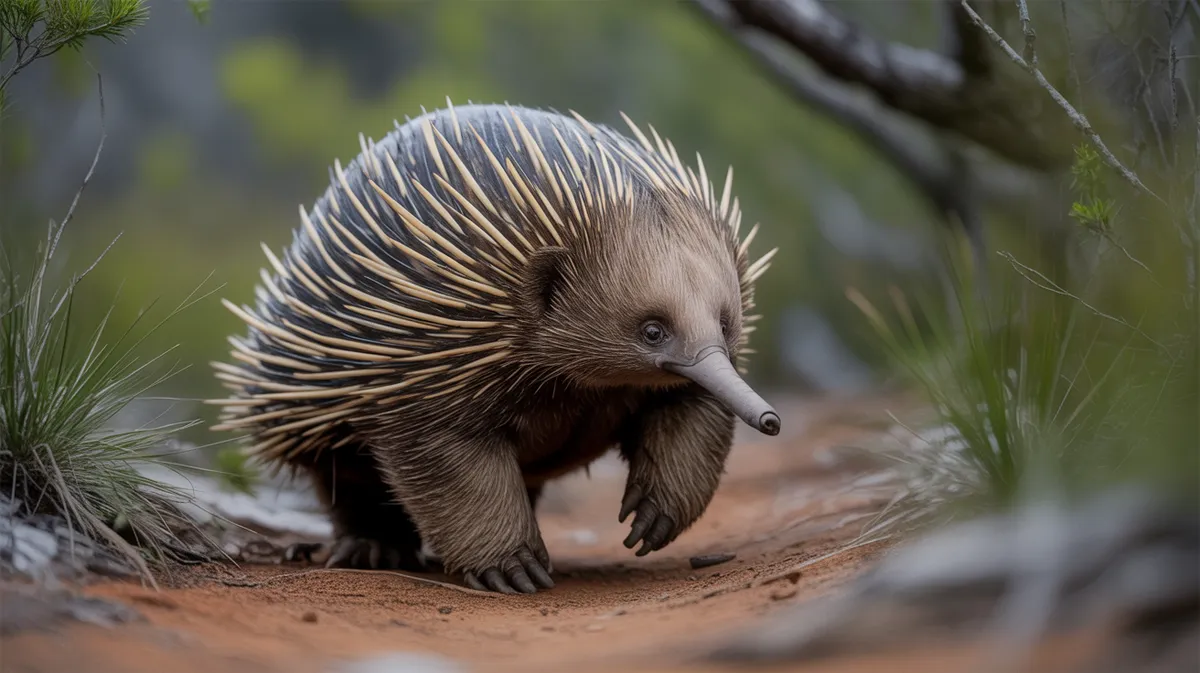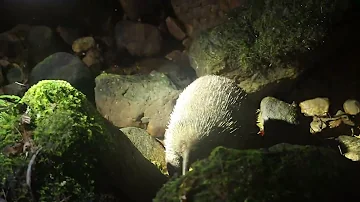
Eastern Long-beaked Echidna
Zaglossus bartoni

Meet the Eastern Long-beaked Echidna
The Eastern Long-beaked Echidna is a spiny, egg-laying mammal native to the montane forests of New Guinea. Unlike its short-beaked Australian relatives, it is larger and characterized by its elongated snout, which it uses to forage for earthworms and insects in the soil. Covered in coarse hair and sharp spines, this echidna is adept at digging and can curl into a ball for protection. Remarkably, it is one of the few monotremes, a primitive group of mammals that lay eggs instead of giving birth to live young.
Classification
Mammal
Habitat
Montane and subalpine forests
Diet
Carnivore
Lifespan
15-30 years
Conservation
Vulnerable
Weight
5-10 kg
📖Fascinating Facts
Egg-laying Mammal
This echidna is a monotreme, meaning it lays eggs rather than giving birth to live young, a rare trait among mammals.
Electroreceptive Snout
Its long, sensitive snout contains electroreceptors that help it locate earthworms and insects underground.
Highland Habitat
The species inhabits the cooler, moist montane forests and subalpine zones of New Guinea, often at elevations over 2,000 meters.
📋Detailed Description
The Eastern Long-beaked Echidna (Zaglossus bartoni) is a robust monotreme, measuring 60–100 cm in length and weighing between 5 and 10 kg, making it the largest extant echidna species. Its body is covered with a dense layer of coarse, dark brown to black fur interspersed with sharp, keratinous spines up to 6 cm long, providing both camouflage and defense. The most distinctive feature is its elongated, downward-curving snout, which houses electroreceptors that detect the electrical signals of prey underground. Unlike the short-beaked echidna, Z. bartoni has three claws on each forelimb and five on each hindlimb, specialized for digging through compact soils and leaf litter. The limbs are powerfully muscled, enabling the animal to burrow rapidly or wedge itself into crevices when threatened. Its tongue is long, sticky, and highly protrusible, adapted for extracting earthworms and insect larvae from soil and decaying wood. The species is primarily terrestrial and nocturnal, with activity peaking during the cooler hours of dusk and dawn. Its solitary nature is reflected in its large, overlapping home ranges, with individuals coming together only for breeding. The Eastern Long-beaked Echidna is a vital component of the montane forest ecosystem, contributing to soil aeration and nutrient cycling through its foraging behavior.
💡 Did you know?
Despite being a mammal, the Eastern Long-beaked Echidna lays eggs and incubates them in a pouch on its belly.
🔬Research & Sources
Wikipedia Summary
The eastern long-beaked echidna, also known as Barton's long-beaked echidna, is one of three species from the genus Zaglossus to occur in New Guinea. It is found mainly in the eastern half at elevations between 2,000 and 3,000 metres.
Last Modified: 10/17/2024
🎭Behavior & Social Structure
Eastern Long-beaked Echidnas are predominantly solitary and exhibit secretive, elusive behavior. They spend much of their time foraging by probing the soil and leaf litter with their sensitive snouts, using electroreception to locate earthworms, their primary food source, as well as other invertebrates. Foraging bouts are interspersed with periods of rest in self-dug burrows or under dense vegetation. They are primarily crepuscular and nocturnal, likely an adaptation to avoid diurnal predators and temperature extremes. When threatened, they employ a defensive strategy of digging rapidly into the ground or curling into a tight ball, exposing only their spines. Social interactions are minimal outside the breeding season, and individuals maintain exclusive territories marked by scent glands. Communication is limited, with chemical cues playing a more significant role than vocalizations.
👶Reproduction & Life Cycle
Breeding in Zaglossus bartoni is believed to occur seasonally, likely coinciding with the rainy season (November to April) when food resources are abundant. Courtship involves males following scent trails left by receptive females. After mating, the female lays a single leathery egg directly into her backward-facing pouch after a gestation period of about 21–28 days. The egg hatches after approximately 10 days, and the altricial young (puggle) remains in the pouch for up to 50 days, feeding on milk secreted from specialized mammary glands (as monotremes lack nipples). Once the spines begin to develop, the mother transfers the puggle to a burrow, where she continues to nurse it for several months until it is weaned and independent. Parental care is solely provided by the female.
🛡️Adaptations & Survival
Zaglossus bartoni exhibits several unique adaptations for its high-altitude, montane habitat. Its dense fur and spines provide insulation against cold temperatures found at elevations of 2,000–3,000 meters. The elongated, flexible snout is equipped with electroreceptors, allowing it to detect the faint electrical signals of subterranean prey. Powerful forelimbs and specialized claws facilitate efficient digging in compact soils. The species has a low metabolic rate, an adaptation to the nutrient-poor environment and sporadic food availability. Its ability to curl into a spiny ball offers effective protection against predators such as feral dogs and birds of prey. The backward-facing pouch protects eggs and young from debris while the mother digs.
📚Research Sources
🎨Cultural Significance
The Eastern Long-beaked Echidna holds cultural importance for several indigenous groups in Papua New Guinea, where it is known by various local names and often features in folklore as a symbol of resilience and adaptability. Traditionally, it has been hunted for its meat, which is considered a delicacy, and its spines, which are sometimes used as ornaments or tools. In recent years, conservation efforts have included community education programs to promote sustainable practices and highlight the species’ ecological value.
🔬Recent Research & Discoveries
Recent research has focused on the taxonomy and genetic diversity of Zaglossus bartoni, revealing the existence of several subspecies based on morphological and geographic variation. Ongoing field studies are investigating its population density, habitat preferences, and reproductive biology, often using camera traps and environmental DNA (eDNA) sampling due to the animal’s elusive nature. Advances in non-invasive monitoring techniques have improved understanding of its distribution and abundance. Conservation genetics studies are underway to assess genetic health and inform management strategies. The species is also of evolutionary interest, providing insights into monotreme biology and the early divergence of mammals.
🎥Wildlife Videos

Echidna | World's Weirdest
#NatGeoWILD #WorldsWeirdest #Echidnas About World's Weirdest: A buffalo with three eyes, an exterminator who eats his day's ...
Nat Geo Animals

The Mysterious Western Long Beaked Echidna Nature's Enigma
Join us on an incredible wildlife adventure as we explore the rare Western Long-Beaked Echidna (Zaglossus bruijni) in this ...
PlanTrip

Wild Western Long-beaked Echidna, Zaglossus bruijni
A critically endangered Western Long-beaked Echidna (Zaglossus bruijni), near Sorong, West Papua, June 2023. One of the ...
Mammalwatching

A Close Encounter with Endearing Echidnas | The Making of Mammals | BBC Earth
Is it a hedgehog? Is it a porcupine? No, it's an echidna! These spiky ant-eaters are usually solitary creatures, but the combination ...
BBC Earth

What Does The Eastern Long-beaked Echidna Look Like? - The Wild Life Explorer
What Does The Eastern Long-beaked Echidna Look Like? In this informative video, we will take a closer look at the Eastern ...
The Wild Life Explorer

10 Things You Didn’t Know About Echidnas!
Few creatures are as bizarre as echidnas! So in this video we talk about 10 of the wildest, and weirdest facts, which we think you ...
Wannon Creek Wildlife
🌍Habitat Information
The Eastern Long-beaked Echidna typically inhabits Montane and subalpine forests environments. Eastern Long-beaked Echidnas have adapted to their environments with specialized features and behaviors.
Primary Habitat:
Montane and subalpine forests
More detailed habitat information will be available soon.
🛡️Conservation Status
The Eastern Long-beaked Echidna is currently classified as Vulnerable. Conservation efforts are crucial for preserving this species for future generations.
Common Threats:
- 🏠Habitat loss and fragmentation
- 🌡️Climate change impacts
- 🎯Hunting and poaching
- 🏭Human-wildlife conflict
⚠️Threats & Conservation Challenges
The Eastern Long-beaked Echidna is classified as Vulnerable due to ongoing population declines. Major threats include habitat loss from logging, agricultural expansion, and infrastructure development in New Guinea’s highlands. Hunting for bushmeat by local communities poses a significant threat, as the species is considered a traditional delicacy. Its slow reproductive rate and specialized habitat requirements make it particularly susceptible to environmental changes. Additional pressures include predation by introduced species (e.g., dogs, pigs) and the impacts of climate change, which may alter montane forest ecosystems. Fragmentation of populations increases the risk of local extinctions and reduces genetic diversity.
🔬Scientific Classification
Scientific Name
Zaglossus bartoni
Classification Hierarchy
🔍 About Taxonomic Classification
Taxonomic classification is a hierarchical system used by scientists to classify and organize living organisms based on shared characteristics and evolutionary relationships.
The system moves from broad categories (Kingdom) to increasingly specific ones, with each animal's scientific name typically consisting of its Genus and species.
📝Community Notes
Share your observations and insights about the Eastern Long-beaked Echidna with our community of wildlife enthusiasts.
Join Our Community
Sign in to share your observations and connect with fellow wildlife enthusiasts.
Sign In to ContributeNo community notes yet
Be the first to share your observations about the Eastern Long-beaked Echidna!
Explore Eastern Long-beaked Echidna
Select a tab above to learn more about this amazing animal.
📸Photo Gallery
No photos available for this animal yet.
🌟Discover More Wildlife
Continue your journey of discovery with more fascinating animals from our database
